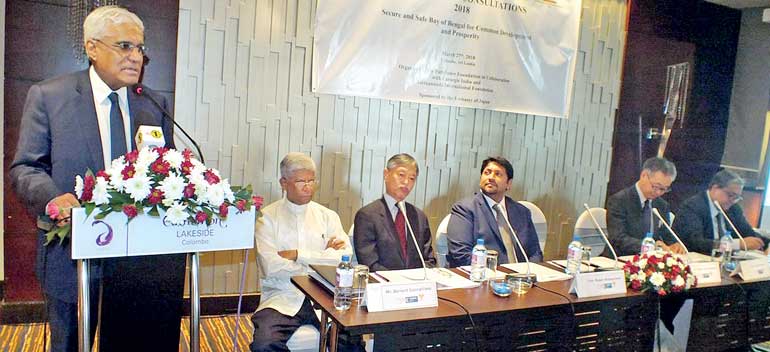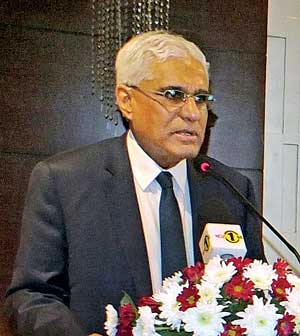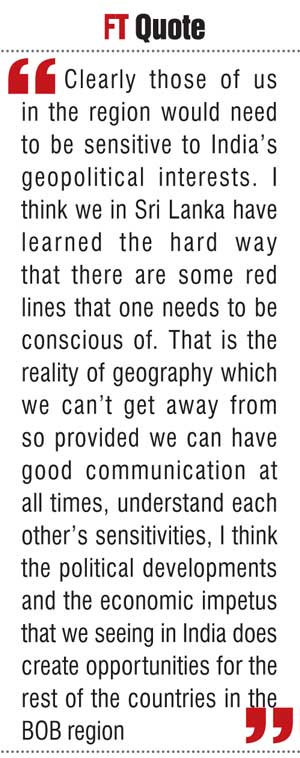Tuesday Mar 04, 2025
Tuesday Mar 04, 2025
Tuesday, 3 April 2018 00:00 - - {{hitsCtrl.values.hits}}

‘Trincomalee Consultations – 2018’ was conducted by The Pathfinder Foundation’s Centre for Indo-Lanka Initiatives recently in Colombo. The event, convened in collaboration with two New Delhi-based think-tanks Carnegie India and Vivekananda International Foundation, was sponsored by Japan. The theme of the conference was ‘A Secure and Safe Bay of Bengal for Common Development and Prosperity’. Countries attending the event were Bangladesh, India, Japan, Myanmar, Nepal, Singapore and Sri Lanka. The keynote speaker Governor of the Central Bank, Dr. Indrajit Coomaraswamy, highlighted the need for integration of the Bay of Bengal countries for common prosperity under a rule-based framework. Here is the full speech made by Governor at the ‘Trincomalee Consultations – 2018’:
 There are those, almost everybody I suspect in the room, far better versed than I am on matters related to security and so I am going to focus on economic issues which I hope can add some value to the discussions today.
There are those, almost everybody I suspect in the room, far better versed than I am on matters related to security and so I am going to focus on economic issues which I hope can add some value to the discussions today.
What is happening in terms of the dynamics of the Bay of Bengal region which may be changing the prospects of the countries of the region? As you know, South Asia is the least integrated region in the world if you look at trade, investment it’s less integrated than every other region and sub region in the world and even the BIMSTEC region hasn’t got the traction I suspect all of us hoped it would. So, what are the prospects of things changing? That’s really the question I tried to answer and let me share some thoughts on it.
Learn from East Asia
I think it’s realistic to say that within the SAARC framework progress will continue to be very muted. There is much we in this region can learn from East Asia. There is a somewhat troubled history between Japan and Korea, between Japan and China, but it doesn’t stop them from doing billions and billions of dollars’ worth of business. There are tremendously strong commercial relations among those three countries. 
In South Asia we have not being able to transcend our historical legacy. I think the difference is that the East Asians are very pragmatic and very focused on commercial advantage. In South Asia we tend to be rather emotional and somewhat easily distracted. That’s the difference and that’s not going to change in the near future.
So what about the rest of the Bay of Bengal region? There I suspect the narrative is different. There are changes which were already beginning to see, which I think are opening up new possibilities. Already if you look at the northeast of the sub-continent, you look at rail and road transit, energy grid sharing, even water sharing now there is progress being made between India, Bangladesh Nepal, Bhutan, etc. so there is real progress which wasn’t there maybe five years ago.
In the South we’ve made some progress in terms of grid connectivity and of course Sri Lanka and India negotiating the Economic and Technical Cooperation Agreement (ETCA) which I think can be a very useful template for other countries in the Bay of Bengal region as well.
Arguably the biggest change factor is really India’s posture in the region. I will take the political and then the economic changes and the dynamics of India’s position vis-à-vis its neighbourhood. I suspect India’s ‘Neighbourhood First’ policy is rooted at least in part to a clear recognition that instability and friction in the neighbourhood will compromise India’s ambitions as a global power and a rising global player. So it is in India’s interest to invest in the peace and security of the region. And there seems to be a consensus across the major political groups in India, the last two governments have both been committed to the neighbourhood which really opens up a lot of opportunities by changing the overall landscape within which bilateral relations within the overall Bay of Bengal region are evolving.
There are also changes as far as the economic dimensions are concerned, again spreading out from what is happening in India. The rise of Japan and then China pulled the whole of East and Southeast Asia up along with them. Economists talk about the ‘wild geese formation’ where Japan was first the lead goose and then China and the other countries followed largely through cross border production sharing arrangements. The various supply chains that were created as Japanese and then Chinese manufacturing came to dominate the world. 
We haven’t had that kind of scenario. India’s growth has been muted. It’s been at a higher level since 1991 but more recently now that the effects of demonetisation are wearing out and the glitches with the General Services Tax are being resolved, there is now the prospect of India which is already the fastest-growing large economy in the world being able to sustain 7% plus growth for some time and if that happens that should create opportunities for the countries in the world particularly if India’s ‘Make in India’ strategy gains traction because that will then create the supply chains and the cross border production sharing arrangements which we have seen to the East of us being replicated in the Bay of Bengal region as well.
These are all important changes that are taking place which have in many ways transformed the opportunities that are possible for countries in the Bay of Bengal region. Historically, particularly the small countries in the region, have tended, and as small countries which are neighbours to much larger countries all over the world feel, have historically thought of India as much as a threat than an opportunity but now I think the way India’s political interests and global interests on the one hand and it’s economic development on and the other are evolving I think the opportunities far outweigh any potential threat.
But clearly those of us in the region would need to be sensitive to India’s geopolitical interests. I think we in Sri Lanka have learned the hard way that there are some red lines that one needs to be conscious of. That is the reality of geography which we can’t get away from so provided we can have good communication at all times, understand each other’s sensitivities, I think the political developments and the economic impetus that we seeing in India does create opportunities for the rest of the countries in the BOB region.
ETCA as a template
Let me finish by saying why I think that the ETCA that SL is negotiating with India can be used as a template for other countries in the region. Whenever small countries negotiate bilateral agreements with much larger countries, clearly there is genuine and understandable concern about the asymmetry of the economies involved. So how does one deal with that asymmetry, so that you get a win-win situation whereby the smaller country also benefits?
Fortunately we don’t need to reinvent the wheel. There are other agreements from which we can learn and one lesson is the agreement between a smaller and later country must be based on the principle of non-reciprocity and special and differential treatment. What that means in practice is that the smaller country would have much longer negative lists when it comes to trade in goods, much shorter positive lists when it comes to trade in services and the smaller country will have much longer transition periods in terms of the liberalisation that has been agreed as part of the trade deal. 
And also there are safeguard arrangements and antidumping laws which you can introduce – Sri Lanka just introduced an anti-dumping and safeguards provisions law. What the safeguard provisions do is you can set a limit in terms of an import surge. You can say, if imports grow faster than 15% in a year you can trigger off some tariffs. So this is again protection that a small country can have in terms of safeguards and also clearly anti-dumping legislation is necessary to ensure that there isn’t any industry which is adversely affected by dumping by being swamped by cheap imports.
There are these well-known principles as well as mechanisms that can be used to ensure that the smaller country does get a decent deal when negotiating with the larger country. One can also build in a robust dispute resolution mechanism. This is very important. Let’s assume that there is no agreement between Sri Lanka and India and other countries also don’t have agreements with India. The Indian economy is going to continue to grow and grow fast. The asymmetry between India and its neighbours is going to increase. In such a context it’s in the interest of the smaller country to have a rules-based framework within which trade, investment, etc. takes place because if you don’t have those rules, given the size of the Indian economy, given the rate of growth India is going to record, it will be a much more untidy and potentially more disruptive process if you don’t have a rules-based framework to govern the bilateral relationship between the two countries.
In fact it’s not often understood that rules-based frameworks are actually the protection for small and vulnerable countries. If you can, the more rules-based frameworks you can to determine bilateral and international relations, the greater protection there is for relatively smaller countries. There is a very, very strong rationale for putting this bilateral relationship, whether its Sri Lanka, Nepal or Bangladesh, Bhutan or Myanmar, to put the relationship with a much larger player in the region, with the fast growing in the region within a rules-based framework whereby the relationships between a smaller country than India can evolve within a predictable and stable environment.
Trincomalee
Finally let me talk a little bit about Trincomalee. Clearly if the BOB region takes off, the strategic importance of Trincomalee which has been known for millennia would be reinforced even further. Not only just the port which is very well placed as a hub for the BOB region but also the hinterland around Trincomalee can be developed, whereby it can become an engine of growth not only for Sri Lanka but for the broader region as well.
To sum up, from my point of view there are a number of trends which are playing themselves out which have increased the potential for countries in the BOB to grasp opportunities which are now there, which every emerged, which were perhaps not there are five-10years ago, so the challenge now is to grasp these opportunities, to negotiate effectively to make sure that each of our national interests are pursued vigorously within a corporate of framework.
Discover Kapruka, the leading online shopping platform in Sri Lanka, where you can conveniently send Gifts and Flowers to your loved ones for any event including Valentine ’s Day. Explore a wide range of popular Shopping Categories on Kapruka, including Toys, Groceries, Electronics, Birthday Cakes, Fruits, Chocolates, Flower Bouquets, Clothing, Watches, Lingerie, Gift Sets and Jewellery. Also if you’re interested in selling with Kapruka, Partner Central by Kapruka is the best solution to start with. Moreover, through Kapruka Global Shop, you can also enjoy the convenience of purchasing products from renowned platforms like Amazon and eBay and have them delivered to Sri Lanka.
Discover Kapruka, the leading online shopping platform in Sri Lanka, where you can conveniently send Gifts and Flowers to your loved ones for any event including Valentine ’s Day. Explore a wide range of popular Shopping Categories on Kapruka, including Toys, Groceries, Electronics, Birthday Cakes, Fruits, Chocolates, Flower Bouquets, Clothing, Watches, Lingerie, Gift Sets and Jewellery. Also if you’re interested in selling with Kapruka, Partner Central by Kapruka is the best solution to start with. Moreover, through Kapruka Global Shop, you can also enjoy the convenience of purchasing products from renowned platforms like Amazon and eBay and have them delivered to Sri Lanka.